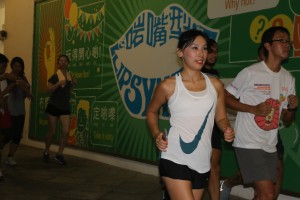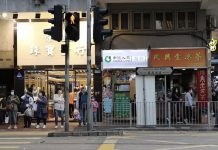Run to meet friends and experience Hong Kong’s neighbourhoods
By Karen Yu
It is 7 p.m. on a Wednesday and Dawn Chan Pui-yan, who is in her late twenties, has just finished work. She walks from her workplace to the nearest MTR station. The rush-hour crowds on the subway have not yet thinned as she makes her way to Central. Despite the crowds and her exhaustion from work, Chan looks forward to her weekly evening runs with friends.

“Your brain is more tired than your body during work,” Chan explains, “so sweating through running can make me less exhausted and motivates me to do better at work.”
Chan is one of Hong Kong’s many running enthusiasts. Chong Hiu-yeung is another. The 36-year-old has 14 years of running experience and observes that the Hong Kong running community has been increasing in recent years. This is reflected in the number of people registering for the Standard Chartered Hong Kong Marathon. Since 2006, the race has attracted more than 40,000 participants, rising to more than 60,000 in 2010 and reaching 73,000 in 2015. Around 74,000 have signed up for next year’s event.
Chong also notes the growing popularity of new running groups organised by the younger people. Compared to the traditional running groups and associations that organise training and mainly run on tracks in sports fields, the new groups adopt different programmes such as running by the harbour or along trails and their runs are opportunities to build up social networks. “[The new running groups] gather and run after work,” says Chong. “They will take photos and dine afterwards, just to have some fun.”
Harbour Runners is one of these new groups. It started in 2010 and every Wednesday, around 100 runners, from all walks of life including farmers, musicians and teachers, run around the city. During the 7km run, they chat with one another about their daily lives and about their surroundings. A group photo marks the end of their run and some will stay and dine together.
For Dawn Chan, who is a public relations manager, Harbour Runners is a platform for social gatherings. “I reserve every Wednesday for Harbour Runners to meet my friends and have an enjoyable dinner with them.” she says, “It has become a part of my life.”
Running has also helped Chan to meet people outside Hong Kong. She travelled to Russia with a girl she met in Harbour Runners two years ago. During their trip, they participated in a local run and made friends with some Russians who showed them round Moscow and St. Petersburg through running.
Ivan Chan Ming-yuen, 28, is a core member of Harbour Runners. Apart from providing a social platform, he explains that Harbour Runners aims to advocate healthy lifestyles as the busy city life easily gives people an excuse to not exercise. Ivan Chan says Harbour Runners provides a relaxing healthy running experience by arranging beginner-friendly routes along the promenades in Tsim Sha Tsui, Central and Wan Chai.

Before joining Harbour Runners, 39-year-old Cyril Lau Kin-wai, who works in one of Hong Kong’s disciplinary forces, smoked, stayed up late and regularly went out drinking with his friends in Lan Kwai Fong. He joined Harbour Runners three years ago to help get in shape to pass the physical training test for his job. Yet, he gradually gave up his unhealthy lifestyle because he discovered the interesting sides of running, such as trying different running routes and improving his own health. More importantly, running has changed his attitude to life.
“My life is more balanced when I run with my friends in my leisure time instead of focusing on practical work and job promotion,” he says. “I know how to live my life instead of surviving.”

In addition to promoting a healthier lifestyle, some new running groups hope to convey a social message to runners. ROC.Crew was founded in 2014. It takes runners through the streets to explore different communities. The crew stops at landmarks with historical value or where interesting incidents took place, such as Pound Lane in Sheung Wan – where stray animals were kept in the 19th century – Tsim Sha Tsui Clock Tower and some old shops selling traditional snacks.
These routes impress ROC.Crew participant Ridge Lau Kwok-fung, 31, because they have helped him to understand more about communities which he might never have seen. He thinks the experience of running into a graffiti-marked back alley in Kwun Tong was remarkable.
“[I realised that] the back alley was not as dirty and dark as people imagine,” he says. “If they are well-maintained, we can have more shortcuts and art works to appreciate.”
Apart from gaining inspiration from the running experience, Lau contributes by sharing his own stories with other runners. Being an alumnus of the City University of Hong Kong, he can share stories of his past student life and he also has many ghost stories to tell when they run through the Kowloon City district.
The 27-year-old ROC.Crew manager Adam Shek Chi-wan welcomes the sharing of personal experiences by the runners. “Our emphasis on giving tours with ‘story-telling’ elements differentiates us from other running crews,” he says.
Shek thinks that more people are joining the community runs as a means to start exercising more. Due to the increase in the number of participants, ROC.Crew now has two community run crews. Both have around 40 runners from different backgrounds, aged between 20 and 40. One runs in Kowloon and the other in Hong Kong.
In comparison with cities built on a larger scale, Shek thinks there is space in Hong Kong for street running because the city’s density of development has made walking and running a way to commute. “Running 10km in Central is a nice experience in a sense that it enables runners to run through communities with different patterns,” he explains.
The high level of urbanisation also means runners have easier access to MTR stations to get back home after their run, says Shek. Compared to Europe where the range in temperature between night and day is more marked, the relatively mild weather in Hong Kong is another advantage for night running.
Though the physical environment is suitable for running, Shek does not think the government has provided sufficient lockers for storing runners’ personal belongings. “Sports centres are supposed to be places facilitating people to do exercise but they are reluctant to lend us the lockers,” he sighs.
Apart from asking the government to help, he has approached other associations to provide storage spaces to make it easier for runners. “Try to imagine finding a place to store your belongings within 5km, it would be much more convenient,” he says.
However, seasoned runner Chong Hiu-yeung thinks that with so many cars and people on the streets, there is little space for running in Hong Kong except at sports grounds, on jogging trails, harbour fronts and in country parks. He points out the root of the problem: “Space in Hong Kong is expensive while Hong Kong tends to prioritise economic benefits, even the Tsim Sha Tsui Harbour Front is used for expanding the Avenue of Stars.”
He thinks it is impossible to rely on the government to provide more running space because it has never seen sports as an important issue and the runners are so used to this reality that they exert little pressure on the government to improve the situation.
“Hong Kong has the trend [of running],” Chong comments. “But the government has a backward mindset and policies.”
Edited by Edith Lin










































